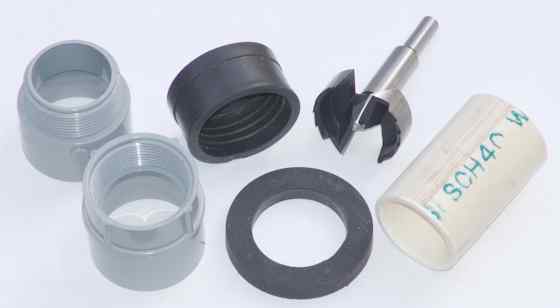 This example shows the construction of a 1-1/2" PVC pipe bulkhead fitting, which will
be installed on the side of a 44-gallon vessel.
Smaller sizes down to 1/2" can be made in the same way.
This example shows the construction of a 1-1/2" PVC pipe bulkhead fitting, which will
be installed on the side of a 44-gallon vessel.
Smaller sizes down to 1/2" can be made in the same way.
A "bulkhead fitting" is an unusual item of plumbing designed to pass a connection through the sealed wall of a vessel. While there are a lot of household and industrial applications for them, you won't find bulkhead fittings at Home Depot. Speciality sources on the Web want $10 or $20 for what should cost pennies. I will show you below how you can easily and inexpensively improvise PVC bulkhead fittings from common parts from the hardware store.
 This example shows the construction of a 1-1/2" PVC pipe bulkhead fitting, which will
be installed on the side of a 44-gallon vessel.
Smaller sizes down to 1/2" can be made in the same way.
This example shows the construction of a 1-1/2" PVC pipe bulkhead fitting, which will
be installed on the side of a 44-gallon vessel.
Smaller sizes down to 1/2" can be made in the same way.
The essential item in constructing a bulkhead fitting is a male-female pair of straight-threaded adapters, which can tighten to form a clamp on both sides of the vessel wall. Since all threaded adapters in ordinary plumbing use tapered threads ("NPT", an abbreviation for American National Standard Taper Pipe Threads), plumbing fittings will not work. However, PVC electrical conduit fittings use straight, not tapered, threads, while the electrical conduit adapters use standard plumbing pipe sizes for glued joints. The PVC material is the same for plumbing or conduit, and as chemically versatile, just being colored gray in the case of the electrical items.
In short, plastic electrical conduit fittings are the secret ingredient to improvising a bulkhead fitting.
The necessary components are shown in the photo, from left to right:
the 1-1/2" PVC male and female electrical conduit adapters, a 1-1/2" Fernco rubber pipe cap,
a Buna-N rubber drain gasket (sold as an item of bathtub drain hardware),
a 1-7/8" Forstner drill bit (which is just a bit smaller than the outside of the
conduit fitting threads), and a short stub piece of 1-1/2" PVC pipe.
We will use the pipe stub and rubber cap to make this bulkhead fitting into a drain.
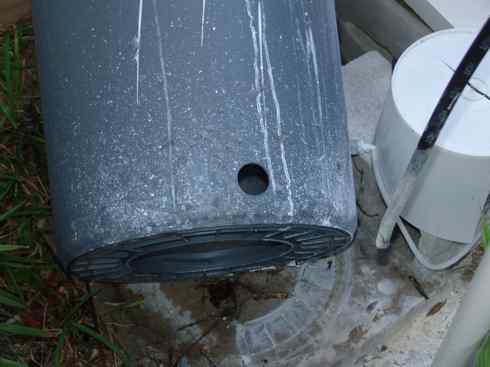 For a vessel, we will use nothing more than a Rubbermaid Brute polyethylene drum, another
"secret ingredient", which makes an excellent liquid storage tank, but is disguised as a trash can
at the store.
The polyethylene material is compatible with many difficult solutions like caustics and acids.
The "Brute" brand is quite sturdy, having been designed to take curbside abuse.
If you were to purchase
a polyethylene chemical tank of that size from a plastics or laboratory equipment supplier, you
would pay many $100s, not to mention an unwieldly shipment problem. Instead we'll use the Rubbermaid
item, readily available at hardware stores like Home Depot or Lowes, and priced at about $25 for the
32-gallon size.
The PVC fittings and gasket are only a few dollars more.
For a vessel, we will use nothing more than a Rubbermaid Brute polyethylene drum, another
"secret ingredient", which makes an excellent liquid storage tank, but is disguised as a trash can
at the store.
The polyethylene material is compatible with many difficult solutions like caustics and acids.
The "Brute" brand is quite sturdy, having been designed to take curbside abuse.
If you were to purchase
a polyethylene chemical tank of that size from a plastics or laboratory equipment supplier, you
would pay many $100s, not to mention an unwieldly shipment problem. Instead we'll use the Rubbermaid
item, readily available at hardware stores like Home Depot or Lowes, and priced at about $25 for the
32-gallon size.
The PVC fittings and gasket are only a few dollars more.
The photo shows the bottom of the tub drilled with the 1-7/8" Forstner bit to receive the 1-1/2" nominal size (about 1.9" actual thread outside diameter) threaded fitting. The plastic is soft enough that if you did not have this bit, you could mark the circle on the tub and cut it out with a razor knife, perhaps rounding out with a file. The fit should be close between the hole and the threaded fittings, but does not have to be exact; the rubber gasket will be supplying the actual seal.
Notice in the photo on the right side of the tank, you can see a smaller 1/2" version of this
bulkhead fitting I previously installed, with an elbow and 1/4" polyethylene tubing connected.
This tubing delivers the liquid stored in the tank to a Pulsafeeder injection pump (covered by an inverted white bucket),
which then injects the liquid under high pressure into the swimming pool main circulation line.
This tank had been in use in this application for some years, which is why it shows some white residue.
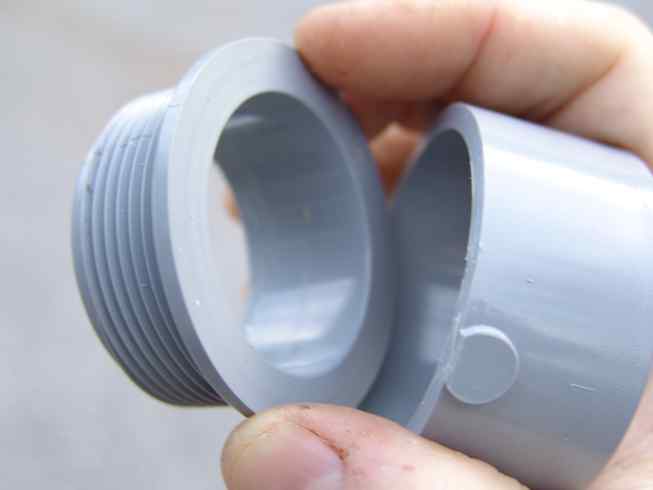 An optional improvement shown here is to trim the inside-the-tank half of the fitting
shorter, removing the pipe adapter portion that will not be used.
I used a lathe to do a neat job, but you could get by with a hacksaw and file.
An optional improvement shown here is to trim the inside-the-tank half of the fitting
shorter, removing the pipe adapter portion that will not be used.
I used a lathe to do a neat job, but you could get by with a hacksaw and file.
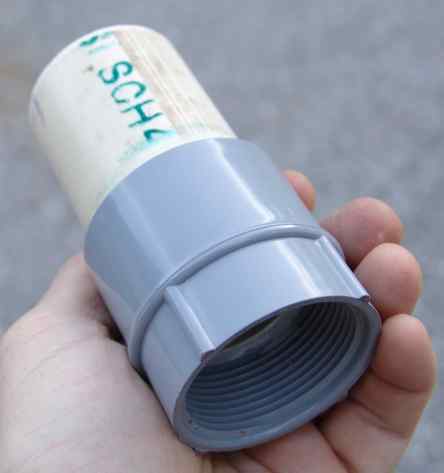 The outside of the assembly is simply the female-threaded adapter with the pipe glued into it.
The outside of the assembly is simply the female-threaded adapter with the pipe glued into it.
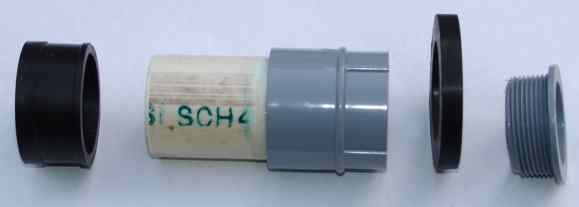 Here are the finished components, ready to be assembled.
From left to right: rubber cap, outside half, rubber gasket ring, and (trimmed) inside half.
Here are the finished components, ready to be assembled.
From left to right: rubber cap, outside half, rubber gasket ring, and (trimmed) inside half.
Instead of the bathtub-drain item,
a gasket could be hand-cut from a sheet of gasket material available as a plumbing item.
A large O-ring from the plumbing or auto parts store is another possibility, although it
would tend to distort since it is not captured in a proper O-ring groove.
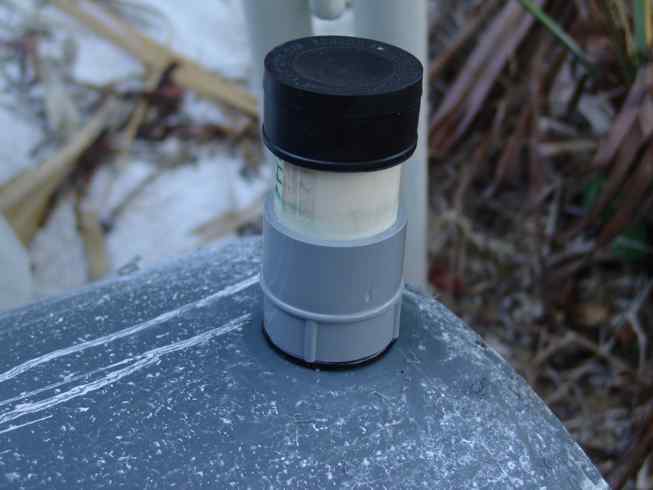 Here is the bulkhead fitting assembled on the hole at the bottom of the tank.
The rubber gasket should go on the outside, between the outside wall of the vessel and the female fitting.
(If the gasket were on the inside, the mated threads would be exposed to the liquid under pressure;
and the threads, being straight, do not seal.)
Putting the gasket on the outside also exposes less of it to contact with the tank contents.
Here is the bulkhead fitting assembled on the hole at the bottom of the tank.
The rubber gasket should go on the outside, between the outside wall of the vessel and the female fitting.
(If the gasket were on the inside, the mated threads would be exposed to the liquid under pressure;
and the threads, being straight, do not seal.)
Putting the gasket on the outside also exposes less of it to contact with the tank contents.
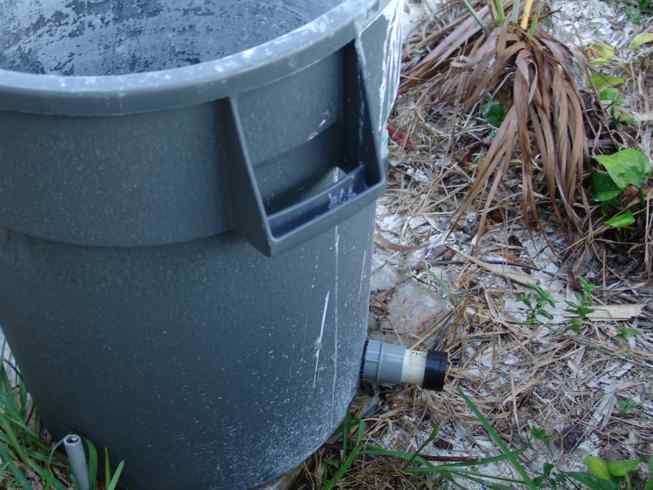 Here's the finished tank and drain ready for service.
This will be holding diluted liquid chlorinator for my swimming pool; the bulkhead drain fitting
will allow the tank to be emptied and rinsed out as is occasionally needed.
The rubber cap is secured with a stainless hose clamp, which is not shown in this photo.
On the other side of the tank, also not shown, is a 1/2 inch version of the same type of improvised fitting,
which connects the liquid chlorinator supply to the intake of an injection pump for my
computer-controlled pool chemistry.
Here's the finished tank and drain ready for service.
This will be holding diluted liquid chlorinator for my swimming pool; the bulkhead drain fitting
will allow the tank to be emptied and rinsed out as is occasionally needed.
The rubber cap is secured with a stainless hose clamp, which is not shown in this photo.
On the other side of the tank, also not shown, is a 1/2 inch version of the same type of improvised fitting,
which connects the liquid chlorinator supply to the intake of an injection pump for my
computer-controlled pool chemistry.
What standard sizes are available? Standard PVC electrical conduit sizes range from 1/2 inch to 6 inches in Schedule 40 (lighter) and Schedule 80 (heavier) thicknesses. However Home Depot and Lowes only seem to carry up to 2 inch sizes. These smaller size increments are 1/2, 3/4, 1, 1-1/4, 1-1/2, and 2 inches.
A ready-made bulkhead fitting you can find in boat stores is a "thru-hull" (through-hull) fitting, which is used to discharge a boat's bilge pump output hose through the hull above the water line. Standard bilge pump line is 3/4" inside diameter plastic hose, and one side of the thru-hull fitting will have a barbed connector for such hose. The other side of the fitting will be unconnected, more or less flush with the outside of the hull. An example is the "Bilge pump plumbing kit" made by SeaSense Marine Accessories, described here, part number 50002344, UPC 737765023448; this particular item requires a 1 inch diameter hole in the bulkhead for the threaded portion of the fitting. This item, or others like it, is sold through retailers like Boater's World, West Marine, Bass Pro Shops, and WalMart.